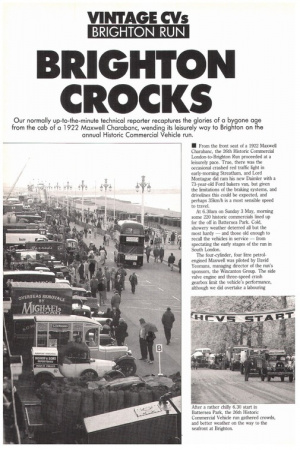BRIGHTON CROCKS
Page 40

Page 41

If you've noticed an error in this article please click here to report it so we can fix it.
IN From the front seat of a 1922 Maxwell Charabanc, the 26th Historic Commercial London-to-Brighton Run proceeded at a leisurely pace. True, there was the occasional crashed red traffic light in early-morning Streatham, and Lord Montague did ram his new Daimler with a 73-year-old Ford bakers van, but given the limitations of the braking systems, and drivelines this could be expected, and perhaps 35krn/h is a most sensible speed to travel.
At 6.30am on Sunday 3 May, morning some 220 historic commercials lined up for the off in Battersea Park. Cold, showery weather deterred all but the most hardy — and those old enough to recall the vehicles in service — from spectating the early stages of the run in South London.
The four-cylinder, four litre petrolengined Maxwell was piloted by David Yeomans, managing director of the run's sponsors, the Wincanton Group. The side valve engine and three-speed crash gearbox limit the vehicle's performance, although we did overtake a labouring steam-powered Sentinel on the Purley Way section of the A23!
'Molly', the 1924 Morris one-tonne van entered by London Carriers, went one better. The drivers stopped two policemen in Croydon to badger them for contributions towards the six sunshine coaches they hope to buy for underprivileged children.
Not all the vehicles were that old, however, although the second-in-dass 1952 Bedford S tipper entered by P Norris belied its tough looks with only a 551cm/h. top speed, and a fuel consumption of around 23.5 lit/100Iun.
With a steel Edbro tipping body, and an underbody ram, the Bedford earned its living with Lea Valley Sand and Gravel before being retired to a scrap yard. In 1980 it was found there in a very rough condition, and restored with a fine cream and brown coachwork.
Further down the route we pass two travelling fairs, with vehicles old enough to be competing in the run. A beautiful Ward la France 1950 fire engine comes past us with its sirens and flashing lights clearing the traffic ahead. After working for the Archville fire department in New York the engine came to the UK last year. The 112kW petrol engine gives it a top speed of 1201an/h, and its water pump spouts 5,682 litres a minute.
A stop for breakfast at the George Hotel in Crawley, and we are back on our way. By this time Molly has been suffering a fuel starvation problem, but as she was only finished off the night before this is good going!
The breakfast stop has had its toll on the steam vehicles too. Clinkers form in the fire box which reduce the heat of the fire, and cause a loss of steam pressure. They stop like stricken whales at the side of the road to re-lay the fire.
As we approach Brighton the roads become dogged with seaside-bound Englishmen, never a breed to give up easily. The Charabanc copes well, although overtaking modern cars vastly over-estimate the power of our brakes.
Brighton seafront is packed with historic vehicles from the 1916 Thornycroft J mobile complete with antiaircraft gun to a 1947 Lacre street cleaning van.
Leyland, AEC, Albion, Commer, even Jensen, Pierce Arrow, and Saurer are represented, radiators gleaming in the occasional patches of sunshine.
YG 746, an open wagon Sentinel, arrives after lunch with its McMullen brewery drivers muttering darkly about the Welsh steam coal that caused the clinkers on the way down: "It's a DG4 you know," they say, brightening up at the thought of lunch. "The double gear system was jolly good as you got almost two vehicles for the price of one, with a high, and low gear."
Standing at the front of the Sentinel, an old man is telling a small boy, "it's a double gear four, they were very good vehicles in their day, although when I drove one for the brewery, we always had trouble with Welsh steam coal..." 0 by Andrew English




















































































